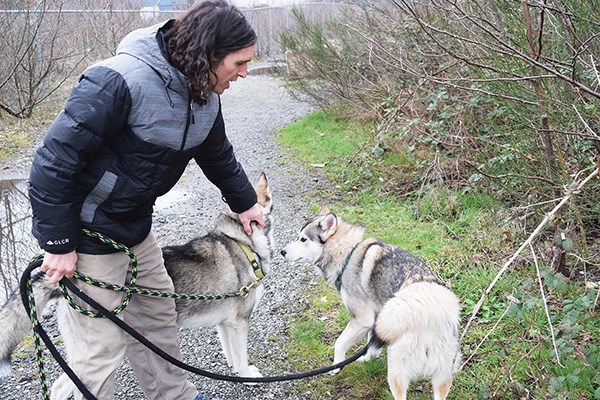Christian Hatt bends down and ruffles the fur of first Raven and then Chief, his two dogs.
The dogs, both timber wolves crossed with red wolf and malamute, lean in to get their owner’s affection as he whispers something inaudible in their ears.
Hatt, who calls himself the “Dogfather,” prides himself on being able to help families eliminate dog behaviour issues, no matter how severe that behaviour is.
A certified veterinary nurse who formerly worked at Squamish Veterinary Hospital, Hatt travelled the U.S. visiting wolf pack sanctuaries to learn more about animal behaviour, “watching them socialize and interact and their pack structure and mentality and how they work out their problems,” he said.
At the top of the wolf pack hierarchy there are alpha leaders, a female and male, that share the leadership, Hatt said. Then there are the betas that behave like uncles, taking care of the pups or watching the den. The youngest, oldest or unrelated wolves in a pack are the omegas that do the front-line hunting or guarding. They also eat last, he explained.
Hatt’s time with the wolf packs had a profound impact on him. Afterward, he became a vocal advocate for ending the provincial wolf cull.
The information he learned watching wolves guides how he helps families with their dog concerns.
“I can go into anybody’s home and restructure their family in relationship to what a wolf pack would look like,” he said. “So if it is a three [person] family, then we tier it, and if it is a seven family, we tier it.”
The dog has to be on the bottom of the hierarchy in a home, “because we are human,” Hatt explained. “The parents become the alphas, the children become the betas, depending on the number of children or their ages… younger children are equal with the dog only in a pack mentality so the dog doesn’t get confused.”
After the hierarchy is figured out, Hatt helps the owners set some basic rules with which the family is comfortable, including discipline, correction, positive reinforcement and affection for the pet.
The mistake most dog owners he works with have made is being too soft, too afraid to be assertive with their pets. “They don’t take control,” he said. “They are afraid they are going to damage their dog… but dogs are genetically programmed to respond to good leadership.”
On the flipside, Hatt said he wishes people who are too aggressive with their pets and not affectionate enough would call him so he could help them with their behaviour and pets, but those people aren’t usually the type to reach out and ask for help.
Lisa Rehel hired Hatt to work with her two-year-old Australian cattle dog, Pepper, three weeks ago and said she has already seen a difference in her aggressive behaviour both in the home and on leash.
“She listens more,” Rehel said. “She is much better on walks, too.”
Rehel said Hatt helped her know how to talk to the dog so she follows direction. “She tends to get wound up but as soon as we tell her, ‘It is all good, we’ve got this,’ she immediately calms down,” she said.
Hatt also teaches pet owners about pet nutrition. Dogs should be fed food as close to what they would eat in the wild such as fish and chicken, he said, not packaged dry food.
Hatt has faced abuse in his life, he casually acknowledges. Rather than a burden, the history of abuse helps him relate to traumatized animals, he said.
When he works with traumatized dogs, that’s where his instincts and his “whispering” kick in, he said.
Hatt was a dog whisperer at least a decade before such a thing entered mainstream consciousness with the arrival of TV dog behaviourist Cesar Millan, he said.
If a dog is abused or severely aggressive, Hatt takes it from its family and spends time one-on-one reconditioning the pet until its is able to reintegrate back into a human family.
“They talk to me,” he said. “They teach me how to treat them.”



